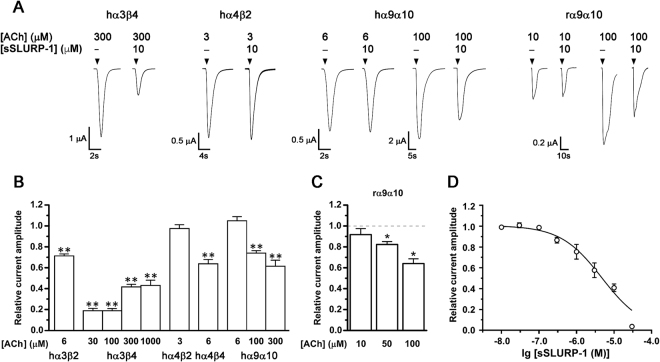Figure 6.
Activity of synthetic SLURP-1 on heteromeric human and rat neuronal nAChRs. (A) Representative ACh-evoked current traces mediated by hα3β4, hα4β2, hα9α10 and rα9α10 nAChRs in the presence of 10 µM sSLURP-1. (B) Bar graph of sSLURP-1 (10 μM) inhibition of ACh (EC50)-evoked current mediated by hα3β2 (6 µM), α3β4 (300 µM), α4β2 (3 µM), α4β4 (6 µM) and α9α10 (6 µM) nAChRs and with ACh concentrations below or above the EC50 for hα3β4 (30, 100 and 1000 µM) and α9α10 (100 and 300 µM). Whole-cell currents were activated by the ACh concentrations indicated. (C) Bar graph of 10 µM sSLURP-1 inhibition of ACh-evoked peak current amplitude mediated by rα9α10 nAChR. ACh concentrations tested were from 10 to 100 µM (ACh EC50 for rα9α10 receptor was 20 μM). Mean ± SEM, n = 6–14. *P < 0.05, **P < 0.0001 vs relative current amplitude in the absence of sSLURP-1, unpaired two-tailed Student’s t-test. (D) Concentration- response curve of sSLURP-1 inhibition of 300 µM ACh-evoked current amplitude mediated by hα3β4 nAChRs. Mean ± SEM, n = 3–10.

